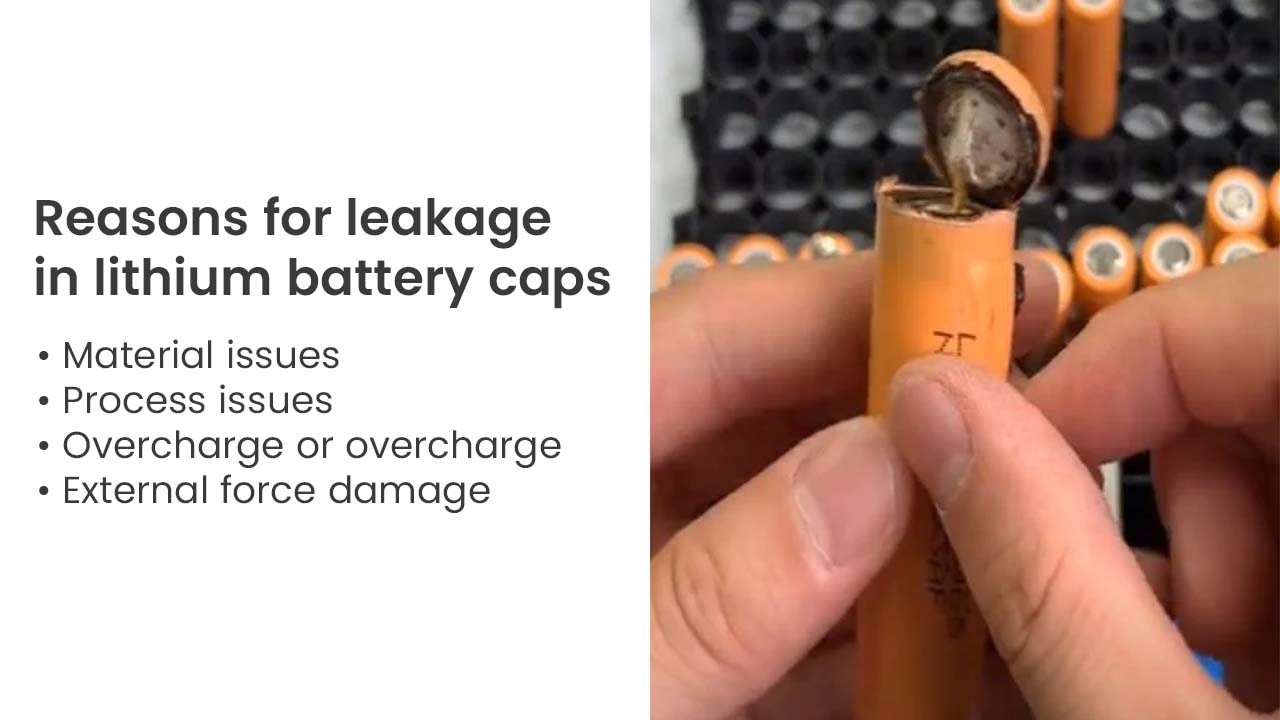
As an efficient and lightweight battery, lithium batteries may encounter leakage from lithium battery caps during use, which will not only affect the service life of the battery but also cause harm to human health.
What then is the cause of the lithium battery cap leaking?
This article will then examine the composition, manufacturing, and structure of lithium batteries.
Lithium battery structure
Positive electrodes, negative electrodes, diaphragms, electrolytes, and shells are the typical components of lithium batteries. Lithium-ion positive materials and negative materials make up the positive and negative electrodes among them, respectively. The electrolyte is used to transfer ions, and the diaphragm is used to isolate the positive and negative electrodes. Protecting the battery’s internal structure, which is often composed of plastic, metal, and other materials, is a major responsibility of the shell.
The principle and function of lithium battery caps
One crucial component of a lithium battery is the cap. Its primary purpose is to safeguard the battery’s internal components and serve as the battery’s seal. The following are some aspects of the principle and operation of lithium battery caps:
1. Protect the internal structure: The lithium battery cap can prevent external objects from damaging the internal structure of the battery and effectively protect the positive, negative, and diaphragm components inside the battery.
2. Sealing function: The lithium battery cap can successfully seal the battery’s internal structure, stop electrolyte leaks, and keep outside air from getting inside the battery, all of which help to keep the battery in its typical operating condition.
3. Pressure: The lithium battery will generate pressure internally during charging and discharging; the cap is designed to withstand this pressure and preserve the battery’s stability.
4. Heat dissipation function: In order to efficiently release the heat produced inside the battery and maintain a safe operating temperature, some lithium battery caps are also built with a heat dissipation structure.
The internal structure, sealing function, pressure and heat dissipation function, and other functions of lithium batteries are all protected and maintained by the lithium battery cap.
Reasons for leakage in lithium battery caps

1. Material issues
Material issues could be one of the causes of lithium battery caps leaking. Because ambient temperature, humidity, and other factors can affect the material of the lithium battery cap, aging, deforestation, and corrosion can occur. These factors can also affect the cap’s sealing performance, potentially causing liquid leakage.
2. Process issues
A potential process issue could be the second cause of the lithium battery cap leakage. When producing lithium batteries, if the cap is not made with enough precision or if there are flaws in the installation procedure, this will also result in the cap’s inadequate sealing performance, which will cause liquid leakage.
3. Overcharge or overcharge
Excessive charging or discharging of lithium battery caps could be the third cause of leakage. The lithium battery’s internal pressure will fluctuate as a result of overcharging or over-discharging, which will impair the cap’s ability to seal and cause liquid leakage.
4. External force damage
The fourth reason for the leakage of lithium battery caps may be external damage. Lithium battery use can result in external forces damaging the battery, which can impair the sealing performance of the cap and allow liquid to leak out.
How to avoid leakage in lithium battery caps
1. Choose high-quality lithium batteries
It is important to choose premium batteries made by reputable manufacturers when purchasing lithium batteries in order to guarantee the integrity and sealing performance of the battery’s internal structure.
2. Pay attention to the environment
When using lithium batteries, it’s important to consider the surrounding temperature, humidity, and other elements to prevent the battery from being exposed to extreme heat, high humidity, or other conditions.
3. Avoid overcharging
To keep the internal pressure of lithium batteries stable, it is best to avoid overcharging or over releasing them.
4. Pay attention to external protection
It is important to take precautions when using lithium batteries to prevent external impact or extrusion.
Conclusion
According to the information above, external force damage, overcharge or over-release, material issues, and process issues could all contribute to lithium battery cap leaks. We should select premium lithium batteries, be mindful of the usage environment, refrain from overcharging or over releasing, pay attention to external protection, etc. to prevent leakage of lithium battery caps. The safety and service life of lithium batteries can only be ensured in this manner.
For More Updates Follow Us
WhatsApp – Facebook – Instagram – Twitter – LinkedIn – YouTube
